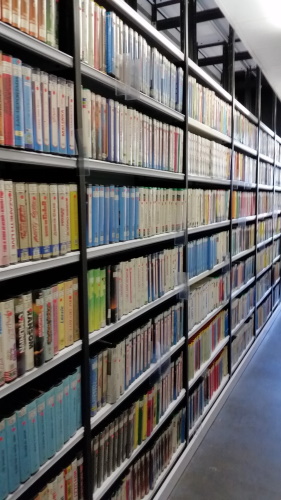Bit List Blog
Email Monkey Magic
Matthew Addis is Co-Founder and CTO of Arkivum based in the UK.
Email Monkey Magic
Email preservation is one of those areas that covers almost every digital preservation issue in the book. This blog post describes my journey into the world of email preservation - what I learnt, what I did, and what we've now built into Arkivum's Perpetua solution. To be honest, it did at times it feel more like the trials of Monkey in Journey to the West but I got to do some cool email magic on the way!
Digitally Designed: Digital Preservation of Architectural records
Adrian Steel is Director of Collections and Programmes at the Royal Institute for British Architects in the UK
Architects have used digital technology to aid design for several decades. The RIBA Collections – which comprise over 4 million items altogether – include the records of Colin St John Wilson and Partners, the architectural practice responsible for the British Library. The British Library was one of the earliest projects to benefit from computer-aided design, and among the surviving records are computer tapes and printouts relating to this pioneering use of technology.
Digitisation and long-term preservation of sound and audiovisual materials at the BNE
Mar Pérez Morillo is Director of Digital Services and Processes at the National Library of Spain
 The National Library of Spain has been digitising its collections since the end of the twentieth century. It launched its digital library in 2007 (for the periodicals) and in 2008 (for the rest of the documents (printed books, manuscripts, incunabula, engravings, maps, music scores, photographs, drawings, etc.). Nowadays the digitised collection comprises more than 2.300 titles of periodicals and more than 220.000 for the rest of the formats, most of them publicly available on the BNE website.
The National Library of Spain has been digitising its collections since the end of the twentieth century. It launched its digital library in 2007 (for the periodicals) and in 2008 (for the rest of the documents (printed books, manuscripts, incunabula, engravings, maps, music scores, photographs, drawings, etc.). Nowadays the digitised collection comprises more than 2.300 titles of periodicals and more than 220.000 for the rest of the formats, most of them publicly available on the BNE website.
The long WARC to freedom
Tom Wilson is Associate Archivist (Digital Preservation) for United Nations High Commissioner for Refugees in Switzerland.
Our recent transfer of web-crawl suppliers taught us that the best laid plans can be derailed by factors beyond one’s control.
UNHCR has been capturing content for its web-archive since 2015, working with Internet Memory Research (IMR) as our supplier to capture, store and display this content. In 2018, IMR informed us that they would be going bankrupt. The timing of this announcement was decidedly inconvenient, as our procurement process for a new supplier had not yet been completed. This left us with the need to download our data from IMR and store it at UNHCR until we knew who our new supplier would be. We therefore drew up a plan to transfer the data, store it and then transfer it to our new supplier, all the while checking that the data remained complete and uncorrupted by this moving and storing.
PDF: you know she’s a little bit dangerous
Yvonne Tunnat is Digital Preservation Project Manager at Leibniz Information Centre for Economics in Germany
When you think about risky file formats, the PDF format is not the first one that springs in your mind isn’t it?
Instead, you might think of old word processing software for C64 or amiga 500, when 'windows' were just some glass to look through. Or, a more recent typical risky file format scenario: the dozen flavours of exotic file formats your institutional scientists give you on a regular basis, insisting that these formats are the only acceptable ones in their specific community and migration to some standard format known to normal population is just too much to ask for.
For us in the Digital Archive of the Leibniz Information Centre for Economics in Kiel/Hamburg, lacking files with such interesting formats – maybe luckily – the danger of our archiving reality lies elsewhere.
Starting with complexity: Archiving digital-born music compositions from Mac systems of the 80s/90s
Beat Mattmann is Data Librarian FDM & DLZA and Iris Lindenmann is Scientific Assistant for Research Data Management at the University of Basel in Switzerland
Background
About ten years ago, a music archive took over the private archive of a composer who had already begun composing with digital techniques in the 1980s. The result is impressive: the composer transferred his work on not less than 700 data carriers to the archive, including 660 floppy discs, 26 SyQuest carriers and a few carriers from the families of Iomega Jaz, Iomega Zip, CD-ROM and Harddisk. The composer has used Apple systems and proprietary special software (music notation and sequencing software) in his work.
Public records – what will be preserved about 2019?
Kuldar Aas is Deputy Director of Digital Archives at the National Archives of Estonia
Let’s get this clear – public records are important. They are the basis for proving the rights and claims of people and organisations, ensuring the transparency of our governments and a crucial piece in preserving a coherent picture of our current societies for future generations. Yet, being a public archives employee myself, I agree there are many aspects which justify the addition of “public records” into the DPC BitList 2019 and in the following I will try to describe some of the most crucial ones from the Estonian public sector point of view.
The first aspect I’d like to mention is – possibly as a surprise to many – the trend of making public information as open and accessible as possible. In this context Estonia has within the last few decades moved from one extreme to another. During the Soviet occupation public records were really “government records” – information was not recorded for the benefit of the people but more for keeping the huge government machinery going. As such the information was not really meant for and open to the public.
Towards Making Palestinian Research Preserved and Accessible
Rawia Awadallah is Manager of the ROMOR Project in Palestine
The Research Output Management through Open Access Institutional Repositories in Palestinian Higher Education (ROMOR) project aimed to build capacity in research output management in four leading Palestinian State (PS) Higher Education Institutions (HEIs) through establishing Open Access Institutional Repositories (OAIRs) to store and share research outputs and increasing support staff capacity to implement and promote repository related policies and services. The Project was led by the Islamic University of Gaza and brought together three other PS partners (Birzeit University, Al Quds Open University, and Palestine Technical University) with four European HEIs (the Technical University of Vienna, Austria; the University of Parma, Italy; the University of Brighton, UK; and the University of Glasgow, UK).
From “research output” to “research data” - a willingness to move forward?
Wachiraporn Klungthanaboon is Lecturer at the Department of Library Science at Chulalongkorn University in Thailand
About 10 years ago, the idea of collocating and providing digital research outputs through an institutional repository or a subject repository for online access was introduced to Thailand. For example, the Library at Chulalongkorn University had built its institutional repository named “CUIR - Chulalongkorn University Intellectual Repositories”. The CUIR has been developed gradually through time in order to serve our users’ information behavior in terms of the increasing number of research outputs, extended collection coverage, and more open access.
Ubiquity and the Floppy Disk: Challenges with Obsolete Carriers
Kevin Molloy is Manuscripts Collection Manger at State Library Victoria in Melbourne, Australia
Floppy disks have a remarkable technological provenance that dates from the late 1960s. Developing through many iterations, the standard 3½ inch disk, produced from 1981, had become largely ubiquitous by the 1990s as the go-to format for business, personal storage and transfer systems. Use of the 3½ floppy lasted until the mid-2000s, and, as a storage device, is found in many physical collections of unpublished papers acquired by State Library Victoria’s Manuscripts Team. Examples from quite diverse collections, include the papers of writers Sonya Hartnett and Peter Carey, the business records of Coles Myer and Bryant and May, the papers of journalist Christopher Bantick, politician Joan Kirner, chefs such as Mietta O’Donnell, and collections like the Miss Australia Company Records.



















































































































































